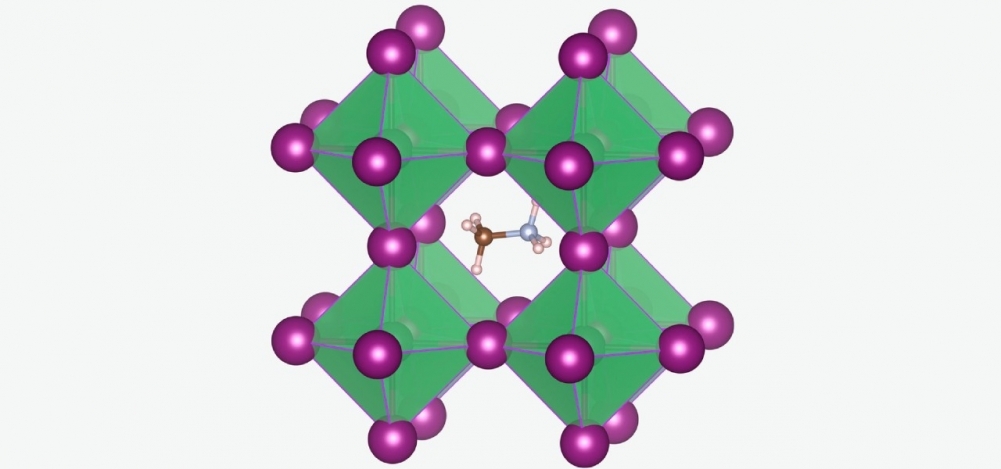

One of the most promising fields is photovoltaics. Prototype perovskite solar cells have been shown to be more efficient than commercial silicon-based cells (crystal structure of methylammonium lead iodide molecule; image: Christopher Eames et al.)
One of the most promising fields is photovoltaics. Prototype perovskite solar cells have been shown to be more efficient than commercial silicon-based cells.
One of the most promising fields is photovoltaics. Prototype perovskite solar cells have been shown to be more efficient than commercial silicon-based cells.

One of the most promising fields is photovoltaics. Prototype perovskite solar cells have been shown to be more efficient than commercial silicon-based cells (crystal structure of methylammonium lead iodide molecule; image: Christopher Eames et al.)
By José Tadeu Arantes | Agência FAPESP – Perovskite is one of the most widely studied materials because of its many potential applications. A particularly promising field is photovoltaics, which involves devices that efficiently convert light into electricity. The conversion efficiency of hybrid perovskite is now around 25.2%, surpassing that of commercial silicon-based solar cells.
An example of hybrid perovskite is methylammonium lead iodide (CH3NH3PbI3). It is called hybrid because the iodine atom’s three negative ions (I-) are balanced against the lead atom’s inorganic positive ion (Pb2+) and methylammonium’s organic positive ion (CH3NH3+).
Focusing precisely on methylammonium lead iodide, a study conducted at São Paulo State University’s Department of Physics and Chemistry (DFQ-UNESP) in Ilha Solteira, Brazil, has advanced scientists’ understanding of the ferroelectric nature of perovskite and the origin of its outstanding photovoltaic properties. An article reporting the findings is published in Acta Materialia.
The study was part of the PhD research of Fernando Brondani Minussi, supervised by Eudes Borges de Araújo, a professor at UNESP. It was supported by FAPESP via the Thematic Project “Multiferroic and ferroelectric materials for energy converters: synthesis, properties, phenomenology and applications”, for which the principal investigator is José Antonio Eiras, a professor at the Federal University of São Carlos (UFSCar), also in São Paulo state. Araújo is a co-principal investigator for the project.
“In this study, we systematically investigated the effect of temperature and a direct-current electric field on the electrical, dielectric and spectroscopic properties of methylammonium lead iodide. We strove to exclude other interferences in order to demonstrate the signature that’s characteristic of the ferroelectric relaxor in the perovskite studied,” Araújo said.
Ferroelectric relaxors are materials whose structure is substantially modified in the presence of an electric field owing to the displacement of ions in the crystal lattice. Positive and negative ions move in opposite directions. They are highly efficient at storing and converting energy because their dielectric constants far surpass those of ordinary ferroelectrics.
“Our findings indicate the nature of the methylammonium lead iodide ferroelectric relaxor, but they also show the existence of a freezing temperature of the dipoles responsible for the relaxor character of the material and a diffuse phase transition at high temperatures. This critical temperature, which affects the relaxor property, is 270 K [-3.15 °C], not far below the freezing point of water,” Araújo said.
Analysis of the results enabled the researchers to propose a novel phase diagram for the system comprising lead iodide and methylammonium, in which they indicate regions that delimit the existence of three distinct phases: ferroelectric, ergodic, and non-ergodic.
“Ferroelectrics naturally exhibit spontaneous electric polarization, which can be reversed by applying an external electric field. This ferroelectric order is destroyed at high temperatures, and the material becomes non-polarized by transforming into a paraelectric phase,” Araújo said. “Classic relaxors exhibit a paraelectric phase at high temperatures, similar in many ways to the paraelectric phase of a normal ferroelectric. When cooled below a certain level known as the ‘Burns temperature’, they start to present polar nanoregions with randomly distributed dipole moments. Because these regions are highly dynamic and not correlated, we say that the relaxor behaves ergodically. The polar nanoregions interact and freeze below a certain temperature, characterizing a non-ergodic state. However, a ferroelectric state can be induced in a non-ergodic relaxor by applying a sufficiently strong electric field.”
In mathematics, the term ergodicity refers to the idea that the average behavior of a system can be deduced from the trajectory of a typical point, but in this case it has a different meaning, according to Araújo, who stressed that although it does not exhibit the behavior expected of a classical relaxor, the relaxor property of methylammonium lead iodide must be intrinsic, and may be eclipsed by ion conductivity and the semiconductive characteristics of the material.
“Generally speaking, ferroelectric relaxors have high levels of dielectric permissivity, and excellent electrocaloric and electromechanical properties. Hysteresis – the tendency for the system to conserve its properties – is suppressed only at sufficiently high temperatures. From the technological standpoint, these characteristics make them strong candidates for the production of acoustic sensors, solid-state coolers, transducers, and actuators. From the scientific standpoint, the fact that ferroelectric relaxors are still the least understood materials in condensed matter physics is a major research stimulus,” Araújo said.
The original and genuinely significant results of the study could potentially help to bring about a paradigm shift in the understanding of ferroelectricity and the origins of the exceptional photovoltaic properties of halide perovskites. “I believe the study substantially advances our understanding of the physics of this complex and fascinating system,” he said.
The article “Effects of frequency, temperature, and dc bias electric field on the dielectric properties of methylammonium lead iodide from the perspective of a relaxor-like ferroelectric” is at: www.sciencedirect.com/science/article/abs/pii/S1359645421006157?via%3Dihub.
Republish
The Agency FAPESP licenses news via Creative Commons (CC-BY-NC-ND) so that they can be republished free of charge and in a simple way by other digital or printed vehicles. Agência FAPESP must be credited as the source of the content being republished and the name of the reporter (if any) must be attributed. Using the HMTL button below allows compliance with these rules, detailed in Digital Republishing Policy FAPESP.





